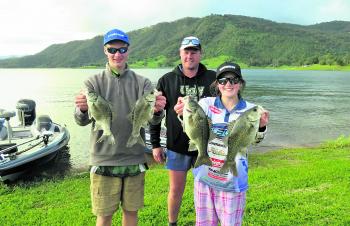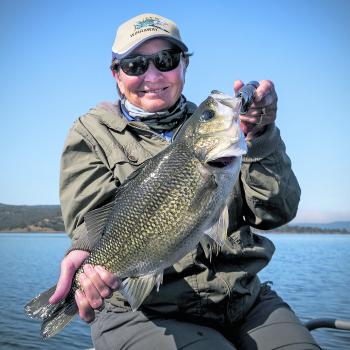Walking the banks of your favourite dam or river can produce some quality fish. In the river, look for overhanging trees or lay downs. It helps if you get to look in advance at the river or dam to check water levels and to give you a fair idea of where the fish will sit when the water comes back up.
There are plenty of cicadas and bugs around at the moment, which makes for excellent topwater fishing. Try Megabass Siglets or Kokada Bats for results. Sometimes the fish are present but won’t take surface patterns; so try using sub-surface lures or shallow ducks as this can switch them on. If using bait, try a float with a short trace, and look around for the insects the fish are feeding on – whether it be cicadas, black crickets, or grasshoppers, the native fish will smash them. In the dams, early morning or late afternoon and into the night are usually the best times to fish. However, overcast days can also produce. A good start area at Glenbawn is down from the Scone Fishing Club, as you don’t get a lot of boat traffic, and there is adequate cover from the sun in the mornings and shade cover in the afternoon. Another spot is Diamond Point and the point of Ski Beach, both of which are great for spinnerbaits, as is around the timber at the Gig.
Lake St Clair is an excellent surface fishing dam. At night from the bank you can get surface hits right in front of your camp. Try fly on surface, just keep walking the bank till you find them and start having fun. By the end of January, water temperature will be getting warmer and the fish will start to school up and sit in deeper water. Lure anglers will go from an adrenaline packed reaction bite using Jackall spinnerbait and surface fishing to the subtle deep vertical bite – deep jigging. Deep jigging is not actually jigging, rather you fish vertical with Gulp minnow grubs in 2-3”. Some anglers prefer to use ZMan 2” Grubz. Bass pros drop these plastics down from 10-20m or even more using light line. I like to use 4lb Berkley Nano Fill with 4lb leader. With the leader I will use up to 8m for two reasons. Firstly, your leader knot doesn’t leave a bubble trail when slow winding up through a school of fish. Bubble trails sometimes put the fish off from following your lure. Secondly, the longer your leader, the more stretch the leader has, which allows you to put more on the fish once hooked.
Use a slow tapered rod for vertical fishing and drop your lure down into the fish (a good sounder will pick up your jighead going down and you can see the fish come up and down with it) then slowly wind. When you get a bite don’t stop and don’t strike just keep slowly winding and you can feel your rod load up. When you think the fish has your bait, slowly lift and set the hook. Fish caught at these depths can suffer barotraumas. There is a lot of information about this issue at www.dpi.nsw.gov.au. Venting fish is something bass tournament fishermen have to do to keep their fish alive and well, Vent a Fish or Bends Mender are tools used to vent fish.
Ty Marchant, a budding young producer and his father Simon have a video on Youtube on Australian bass, check it out at https://m.youtube/watch?v=x_d8agCJkWQ. Another great video on yellow belly is located on Facebook at Big Sump’s Fishing.
• Peter Fogarty runs the popular Lake Glenbawn Kiosk - offering fuel, tackle, ice and the best food on the lake. Make sure you drop in when you visit the lake for the latest reports. You can also visit them on www.lakeglenbawnkiosk.com.au or call on (02) 6543 8355.
Reads: 1478
Scott Hutchinson with son Cole and daughter Jade after a productive day out on Gelnbawn.

Samanatha Anderson caught this absolute chunker of a bass. Look at the belly on this one!




